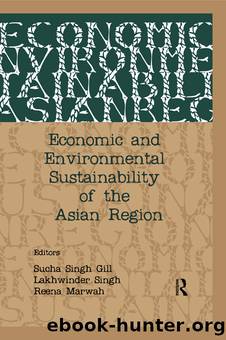Economic and Environmental Sustainability of the Asian Region by Gill Sucha Singh;Singh Lakhwinder;Marwah Reena;

Author:Gill, Sucha Singh;Singh, Lakhwinder;Marwah, Reena;
Language: eng
Format: epub
ISBN: 1099365
Publisher: Taylor & Francis Group
Many donors are becoming increasingly selective in allocating aid, basing their decisions on the performance of recipient countries in terms of policy reforms, stronger governance and programme implementation. Lack of good governance in Sri Lanka is considered to be a major obstacle to the effective use of aid in the future. Lack of trained managers and transparency, poor information systems and lack of systems to address these concerns are some of the main causes of weak public management. Another important problem is the lack of communication between the government and the people regarding the latterâs needs.
Utilisation of aid by sector
To understand the effectiveness of foreign aid in economic and social development in Sri Lanka, we must look at the various heads on which foreign aid has been spent. Table 9.7 provides the sectoral distribution of disbursements of aid during the period 1991 to 2005.
The major sectors on which foreign aid has been spent are agriculture, economic infrastructure, social infrastructure, finance and banking and private sector development. Though there was a continuous increase in total disbursements over the period, it has increased from USD 898.2 million in 1991 to USD 1,018.1 million in 2005.
In 1991, a considerable amount of the aid was spent on agriculture. Investments in agriculture funded by foreign aid focused on provision of irrigation facilities, land, quality seeds, fertiliser, modern agro technologies and storage facilities. However, matching the decline in the importance of agriculture in the economy8, the amount of foreign aid spent on agriculture has also declined over the years. The amount spent on agriculture as a percentage of total disbursements declined from 23 per cent in 1991 to 9 per cent in 2005 (Figure 9.1).
Table 9.7 Aid Disbursements by Sector (in USD million)
Download
This site does not store any files on its server. We only index and link to content provided by other sites. Please contact the content providers to delete copyright contents if any and email us, we'll remove relevant links or contents immediately.
International Integration of the Brazilian Economy by Elias C. Grivoyannis(74798)
The Radium Girls by Kate Moore(11621)
Turbulence by E. J. Noyes(7700)
Nudge - Improving Decisions about Health, Wealth, and Happiness by Thaler Sunstein(7242)
The Black Swan by Nassim Nicholas Taleb(6764)
Rich Dad Poor Dad by Robert T. Kiyosaki(6175)
Pioneering Portfolio Management by David F. Swensen(6079)
Man-made Catastrophes and Risk Information Concealment by Dmitry Chernov & Didier Sornette(5647)
Zero to One by Peter Thiel(5488)
Secrecy World by Jake Bernstein(4388)
Millionaire: The Philanderer, Gambler, and Duelist Who Invented Modern Finance by Janet Gleeson(4094)
The Age of Surveillance Capitalism by Shoshana Zuboff(3985)
Skin in the Game by Nassim Nicholas Taleb(3965)
The Money Culture by Michael Lewis(3846)
Bullshit Jobs by David Graeber(3830)
Skin in the Game: Hidden Asymmetries in Daily Life by Nassim Nicholas Taleb(3723)
The Dhandho Investor by Mohnish Pabrai(3560)
The Wisdom of Finance by Mihir Desai(3523)
Blockchain Basics by Daniel Drescher(3329)
